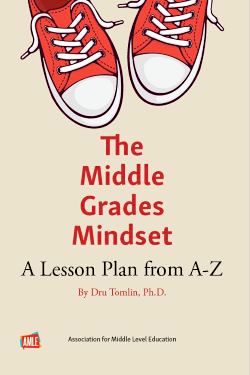Adolescents Thrive on Advocacy and Agency
Dru Tomlin’s book The Middle Grades Mindset offers “A Lesson Plan from A-Z.” It turns out that the lessons are often those learned by Dru himself, over years as a teacher, PD coach, and principal – and during a stint on the AMLE staff as chief joy-bringer. We asked Dru to share just a taste from his rich alphabet soup.
I think advocacy and agency are critical pieces of string woven together in the fabric of middle grades student empowerment. They can’t be pulled apart. When treated with care, the fabric expands and offers security, welcome, and assurance for all students.
From a foodie perspective, they are also essential ingredients in the recipe of positive student growth that cannot be separated. As we allow them to simmer, their flavors complement each other and provide young adolescents with bottomless bowls of emotional nourishment, warmth, and trust.
While they need to always work together, let’s check out each one separately, shall we?
Advocacy First.
As This We Believe: Keys to Educating Young Adolescents (NMSA, 2010) states, an effective and amazing middle school is a place where “every student’s academic and personal development is guided by an adult advocate” (p. 35).
Yes, young adolescents thrive when they know there are reliable, consistent, caring adults in their lives. People who care about them beyond their content areas. People who think about them beyond their test scores. People who offer safe harbor when the adolescent seas get rough.
People who listen to them when the clouds of worry hover and linger. People who speak up for them when they feel like they have no voice. People who communicate – through both word and deed – that there is no such thing as the forgotten middle.
When advocates like this fill our middle schools, young adolescents don’t just attend school. They thrive.
How does this advocacy work happen? Through both expected and unexpected actions. Through scheduled, consistent mechanisms like advisory, interdisciplinary teams, and looping, students bloom because they are supported members of a smaller learning community.
Advocacy also happens through unscheduled, random acts of caring and relationship-building, making students flourish because they realize that positivity is a possibility in any class, doorway, hallway, bus stop, and cafeteria table.
And to be clear, the goal of advocacy work isn’t to create a system of dependency, where students think, believe, or feel like they can’t progress without an adult holding their hands. Rather, the aim is to foster an environment that encourages students to ask bold questions and explore because they know they have a safe place to land.
In fact, when young adolescents have advocates in the middle grades, they develop another powerful mindset: self-efficacy in all areas of their learning lives. When adult advocates are active in the middle grades, a student’s internal monologue of self-efficacy sounds like this:
“My math teacher cares about me and thinks I can do this, so I think I can do this, too. I may struggle, but she’s there when I need her. My reading teacher listens to me and tells me that I’m making progress, so I’m going to keep trying—even though reading is tough for me.
“I can do this. I can make this happen. I can achieve more than this. Because my teachers have my back.”
As students see themselves as actors in their own success, their self-efficacy grows. That’s one of the key by-products of advocacy in the middle grades, and that’s why it’s so essential.
Advocacy Brings About Agency.
Advocacy also drives agency, which is the invisible elevator that exists in every middle school.
Once students gain a sustained sense of self-efficacy (i.e., “I can do this math problem”), they also learn that they have the ability to change their lives beyond the school house. The empowerment they feel when they fix a run-on sentence, solve a science query, or develop a novel idea in social studies fosters more self-efficacy, more empowerment, and more agency.
Indeed, when young adolescents have a sense of agency, they begin to take on leadership roles in their schools and their communities – fixing neighborhood conflicts, solving local issues, developing novel ideas for authentic problems.
How does this agency work happen? Through our daily practice and through larger efforts. Agency is fostered when we promote growth mindset, challenge all students, and encourage creativity and purposeful risk-taking.
Agency is also grown through larger initiatives, such as service-learning projects. Not only do service-learning projects bring interdisciplinary learning to life, but they show young adolescents that they can research an issue that matters to them, that they can take action, and that they can have actual impact. That is agency in action.
Purposeful and On Target
This kind of learning also transforms how other people see middle school students. Instead of characterizing them as aimless, the community will begin to see them as purposeful and on target. In other words, the invisible elevator of agency has the ability to lift students up and take them to levels they once thought unachievable—and to show the world what young adolescents can achieve.
Here are five questions we can ponder together as we lead our students forward:
- How does your middle school advocate for all students?
- Do your students have a sense of agency? How do you know?
- What specific actions, initiatives, and programs are being used to foster agency in your school?
- Who advocates for you—as a teacher, administrator, staff member?
- Do you feel like you have agency over your learning life? Why or why not?
So, middle grades educators, buckle up and help me figure out how we take such a big, complex thing like middle level education and get to its essence. Grab the cognitive utensils in your mental kitchen and let’s discover how we can blend advocacy and agency into everything we do.
Dr. Dru Tomlin is Principal of Heritage Middle School in the Westerville (OH) City Schools. He taught middle and high school English Language Arts, Social Studies and Reading for 10 years in Virginia and in metro Atlanta GA, where he also served as principal at both the elementary and middle levels and was a Georgia Middle School Assistant Principal of the Year.

Tomlin earned his Ph.D. in Teaching and Learning and a M.S. in Educational Leadership from Georgia State University, a B.A. in English/Secondary Education from James Madison University, “and a Certificate of Perfect Attendance from Lynnhaven Junior High School.” Follow him on X-Twitter @DruTomlin4Edu.

































